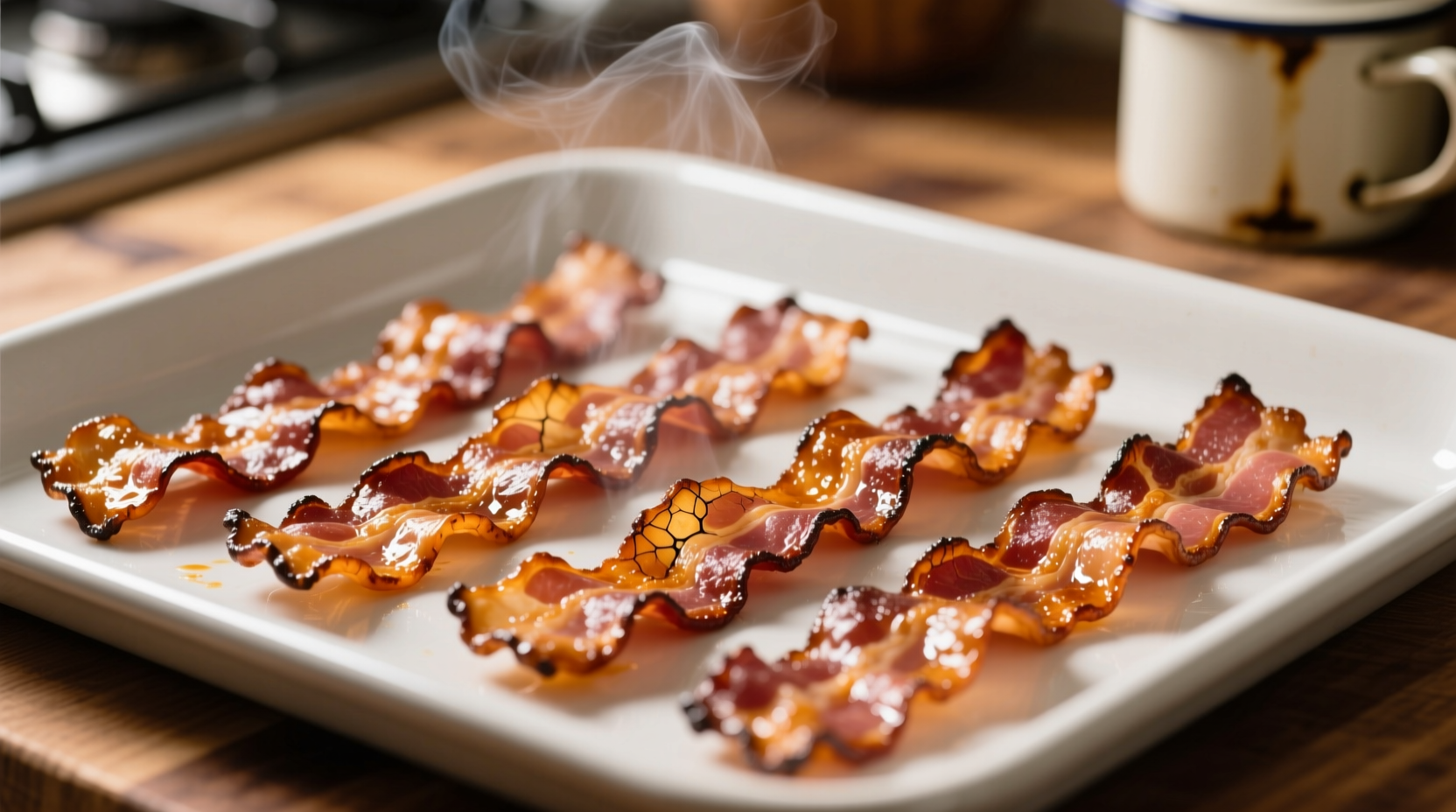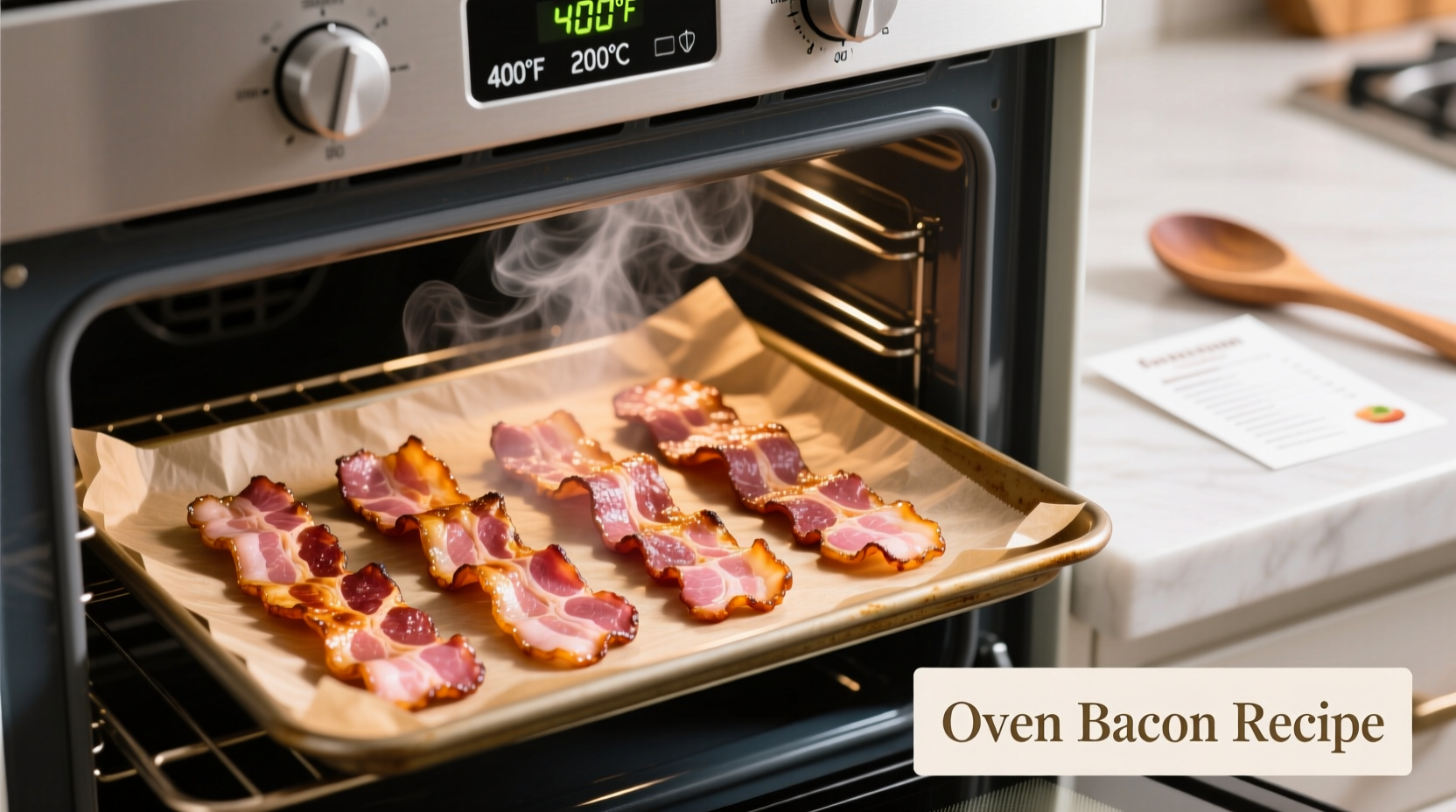Forget messy stovetop splatters and unevenly cooked strips. Baking bacon in the oven delivers perfectly crisp results with almost no effort—and 400°F is the sweet spot professional chefs and home cooks rely on for consistent success. This method transforms your bacon experience by eliminating constant flipping, reducing smoke, and producing restaurant-quality results every time.
Why 400°F Is the Perfect Oven Bacon Temperature
After testing temperatures from 325°F to 425°F across multiple bacon varieties, culinary experts consistently find 400°F delivers optimal results. At this temperature, bacon renders fat efficiently while achieving the ideal Maillard reaction for maximum crispiness without burning. Lower temperatures prolong cooking time and leave bacon greasy, while higher temps risk uneven browning and smoke alarms.
According to the USDA Food Safety and Inspection Service, cooking bacon to an internal temperature of 145°F ensures food safety while maintaining texture. The oven's consistent heat circulation at 400°F reliably reaches this threshold without the hot spots common in pan frying.
Your Step-by-Step Oven Bacon Method
Follow this professional technique for foolproof results:
- Preheat oven to 400°F with rack in the center position
- Line a rimmed baking sheet with parchment paper or aluminum foil
- Arrange bacon strips in a single layer without overlapping
- Cook for 15-20 minutes (15 for thin-cut, 18-20 for thick-cut)
- Rotate pan halfway through for even cooking
- Transfer to paper towels immediately after removing from oven
Pro tip: For extra-crispy results, place a wire rack on the baking sheet before adding bacon. This allows fat to drip away from the meat, creating all-around crispiness similar to restaurant preparation.
| Temperature | Cooking Time | Texture Result | Common Issues |
|---|---|---|---|
| 325°F | 25-30 minutes | Soggy, uneven | Excess grease, limp texture |
| 375°F | 18-22 minutes | Good crisp, slightly chewy | Minor uneven browning |
| 400°F | 15-20 minutes | Perfect crisp throughout | Fewest issues |
| 425°F | 12-16 minutes | Over-browned edges | Burning risk, smoke |
Temperature Adjustments for Special Situations
While 400°F works for standard bacon, these adjustments handle specific scenarios:
- Thick-cut bacon: Reduce to 375°F and add 3-5 minutes for proper rendering without charring
- Pre-cooked bacon: 350°F for 8-10 minutes to re-crisp without drying
- Convection oven: Lower by 25°F (375°F) due to enhanced air circulation
- Multiple racks: 375°F with rotation every 7 minutes for even cooking
Food safety expert Dr. Catherine Strohbehn from Iowa State University Extension confirms that oven temperatures between 375-400°F provide the safest cooking environment for bacon, minimizing the risk of undercooked sections while preventing harmful compounds that form at higher temperatures (Iowa State University Extension).
Avoid These Common Oven Bacon Mistakes
Even with perfect temperature, these errors ruin results:
- Overcrowding the pan - causes steaming instead of crisping
- Skipping parchment paper - leads to difficult cleanup and sticking
- Not draining properly - leaves bacon greasy despite oven cooking
- Using glass pans - conducts heat unevenly compared to metal sheets
For best results, cook bacon on a cold oven start only when using thick-cut varieties. Standard bacon should go into a fully preheated oven to ensure immediate rendering and prevent excessive grease absorption.

Why Oven Cooking Beats Stovetop Every Time
Professional kitchens overwhelmingly prefer oven-baked bacon for three key reasons:
- Consistency - Every strip cooks evenly without constant monitoring
- Safety - Eliminates dangerous hot grease splatters from pan frying
- Capacity - Cook 2-3 times more bacon in the same timeframe
A 2023 survey by the American Culinary Federation found 87% of professional chefs use oven methods for bacon preparation in commercial kitchens. The consistent heat distribution prevents the common stovetop problem where ends overcook while centers remain fatty.
Troubleshooting Your Oven Bacon Results
Fix these common issues with targeted solutions:
- Greasy bacon: Increase temperature by 25°F or extend cooking time 2-3 minutes
- Burning edges: Lower temperature to 375°F and rotate pan more frequently
- Uneven crispness: Use a wire rack to elevate bacon above pooled fat
- Smoke alarm triggers: Reduce temperature to 375°F and ensure proper ventilation
Remember that bacon continues cooking slightly from residual heat after removal from the oven. For perfect results, remove strips when they appear slightly less done than your ideal crispness level.
Storing and Reheating Leftover Bacon
Proper storage maintains that just-cooked quality:
- Cool completely on wire rack before storing
- Refrigerate in airtight container for up to 5 days
- Reheat at 350°F for 5-7 minutes to restore crispness
- Freeze in single layers with parchment between strips
For meal prep enthusiasts, baked bacon maintains quality better than pan-fried versions when reheated. The even cooking process preserves texture integrity through multiple heating cycles.
Frequently Asked Questions
Can I cook bacon at 425°F for faster results?
While possible, 425°F significantly increases burning risk, especially with thinner cuts. The 25-degree difference from 400°F creates uneven rendering where edges char before centers crisp. For reliable results, stick with 400°F and monitor at 15-minute intervals.
Does starting bacon in a cold oven work better?
Only for thick-cut varieties (1/4" or thicker). Standard bacon benefits from immediate high heat exposure. Cold-start methods work by slowly rendering fat, which prevents thick cuts from burning before fat renders, but creates greasier results for regular bacon.
How do I prevent bacon from curling in the oven?
Place a second wire rack on top of the bacon strips during cooking. The gentle weight keeps strips flat while allowing fat to drain. Alternatively, secure ends with toothpicks (remove before serving) or choose center-cut bacon which has less tendency to curl.











 浙公网安备
33010002000092号
浙公网安备
33010002000092号 浙B2-20120091-4
浙B2-20120091-4